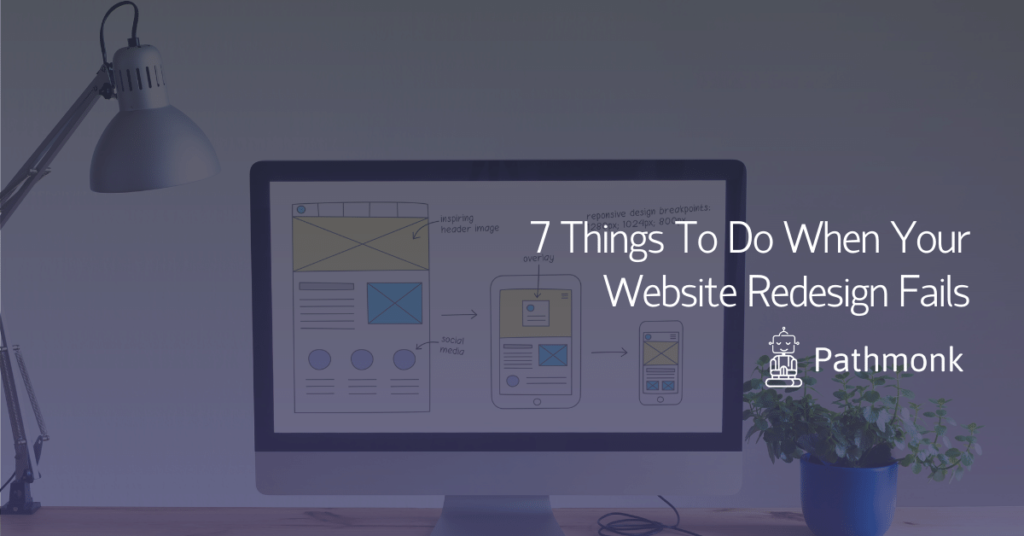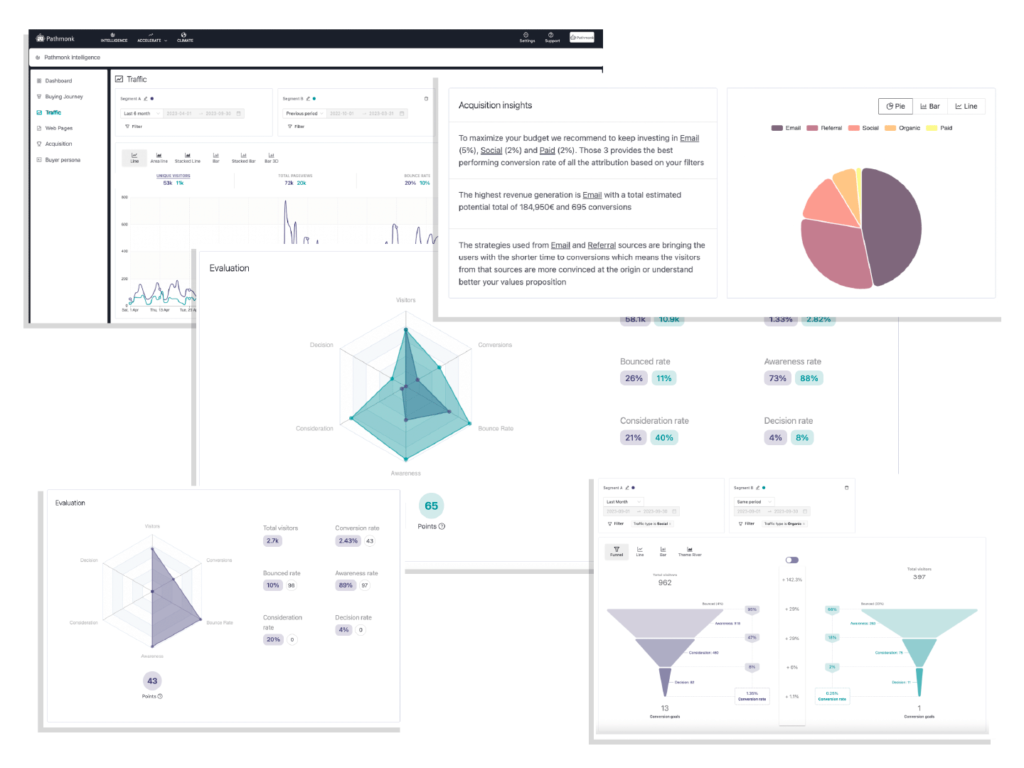7 Things To Do When Your Website Redesign Fails


If you’re unfortunate enough to find yourself a victim of a website redesign gone wrong you don’t need to panic, this guide will help to dig you out from your digital grave and see the light!
At Pathmonk we have thoroughly observed a lot of businesses placing big bets on a website redesigns. It’s very important to understand that those bets often turn out as unpleasant surprises with key business metrics crumbling. That’s why we prepared this guide for you, so that you can make your website redesign bulletproof!
What is the Average Success Rate of a Website Redesign?
Before we begin, I want to show you the statistics; cold, hard facts that clearly demonstrate what implementing a new website design has done for the businesses of proud owners throughout the world. You need to use this to get a sense of what to expect from your new and improved website design. We analysed a study recently and to quickly sum it all up; there is excellent insight into the success rates of various over and under-performing companies. We here at Pathmonk know for a fact that:
- The mean average conversion rate is 2.35%. So you could think that a 2% Conversion Rate is fine but keep in mind the best performers were able to achieve 10% conversion rate.
- This is a significant difference. Think about it. Let’s say your website has 10.000 visitors. A 2.35% Conversion Rate results in 235 prospects while a 10% Conversion Rate are 100 prospects. So now take this difference times your product price…
So what did the best-performing companies do to achieve such high levels of success?
- They made an exclusive, original offer that visitors couldn’t refuse! They offered something that none of their competitors did or had even thought of doing.
- They made their website and all its processes much more user and time friendly.
- They Remarketed
- They tested multiple landing pages, identified the best performers and ditched the lowest!
By using these techniques, these businesses managed to boost their conversion rates and achieve more sales by up to double or even triple of what they achieve beforehand! Therefore, by correctly applying these same techniques to your business you have the potential to achieve similar results. As I mentioned earlier, there are three factors that drastically determined the success rate of these businesses at all times, namely:
- Industry
- Business size
- Competition
It’s important to remember that these statistics are exclusively applicable to each company and your website redesign most likely won’t achieve the same results based on these key, differing factors, which brings us to our next point.
Realistic Expectations of Web Redesigns
When you redesign your website the potential to achieve success is limitless, if you play your cards right you can end up with conversions and sales going through the roof! But as I said moments ago, the statistics achieved by others won’t be the same for you and it is for that very reason why you need to be realistic about your new website design and what it can achieve. While yes it’s true that the potential for success is huge, there also exists the potential for little to no movement or even a negative effect!
I want to be clear that just as you cannot predict the winning lottery numbers – you also cannot predict how your new website design will impact your business and clients.
If you have not yet begun your new website design and don’t know what could happen then let me give you an example of a particularly famous redesign gone wrong so that you can learn, plan ahead and know what not to do.
Gawker Media:
Although a considerably old case, the lesson remains, thus Gawker Media – owner of websites such as LifeHacker, Gizmodo, and Gawker to name a few – conducted a complete redesign of their entire network which the owner Nick Denton stated as being necessary in order to change from a traditional blog format to that of convergence of magazine, television and blog.
The result was chaos: Gawker became so focused on adaptation that they neglected to retain an enjoyable user experience. As a result, multiple users found it difficult to adjust to the new format and could no longer find what they were looking for. Significant numbers of customers both new and old began to leave and by late February (less than one month) the negative effects of the new website design were clear to see with Gizmodo for example, seeing a 60 to 70% drop in visitors since launch! Fortunately, History exists to teach others about our mistakes so that they cannot be repeated.
On that note, with knowledge of the potential consequences and benefits of creating a new website design (extraordinary success, little to no movement or absolute destruction) we here at Pathmonk would like to dedicate the time to ensuring that you are given the best opportunity to achieve new and unimaginable success! A goal which is completely possible with the right information, that ‘information’ being what we at provide to you today.
The 7 Steps
Just as Gawker’s failed to maintain in February 2011, many websites to this day show an obvious lack in providing a user-friendly experience (especially on mobile) and in some cases core functionality. We also noticed that a percentage of business owners wait months, and in some cases more than a year – yes we have seen waiting times this long!
Our team has undertaken usability and UX optimization testing for new website designs across education sites, real estate and automotive. We learned that a surprisingly large amount of redesigned websites fail to reach prior levels of user engagement and many face dropping conversion rates. After redesigning and potentially re-platforming it is very possible that you will see a pretty big drop in revenue.
See below a scenario that is typical of what we have seen:
| User | Revenue | Conv rate | *Sessions* | |
| March (before redesign) 2018 | 13000 | 82000 | 1.14% | 16000 |
| March (after redesign) 2019 | 12000 | 23000 | 0.68 | 15000 |
There are many reasons why business performance can drop after a new website design. So if your website is affected we have for you the top 7 things to do if you see your conversion rates dropping. Likewise, take those into consideration even if you are just starting the planning of your new website design in the near future in order to make sure you won’t miss out on revenue.
Here are the 7 most important things to do:
- Broken functionality such as a “buy now” or “submit now” button that goes nowhere on key actions for your website. If the buy button is broken you may have a situation where existing customers can reorder but new customers cannot get to the checkout for instance. So make sure you have tried yourself to walk through the most important user journeys.
- Did you lose a significant traffic source of referrals as result of the new website design? For example, perhaps there was a major referrer who was deep-linking into your site in a way that is broken by the new website design and now those referrals go nowhere or to the wrong place. Double check your traffic sources and make sure all links point to the right place.
- Test the mobile experience. Most businesses we work with have mobile traffic north of 60%. Review all the major user journeys on mobile to make sure that the key steps are possible (and ideally delightful) to complete!
- A quick technical analysis. How fast is the site on mobile? Mobile speed can have a significant impact on conversion rates. Now that most visitors come through mobile only, make sure that your new website isn’t slower than the previous one. Use Google’s Page Speed Insights tool to get a good idea of how the site is doing. People want to be able to find answers to their questions as fast as possible — studies by Google show that people really care about the speed of a page. Since July 2018 page speed is even a ranking factor for mobile searches.
- Check website analytics. What does the funnel look like and how do users behave across all browsers? Is there one browser or device that does worse than the other? Review your analytics and from there you can go back to review the key user journeys in that particular browser or on that device.
- Website User Testing. Since you might have spent quite some money on the new website it is worth your while to let a few people (that haven’t seen it before) test the new site. It usually is already enough to do a quick test with 5 people so that you can see what the major issues are. Keep it simple: Take 2-3 major tasks that a new user should try on the website and see what their major challenges are.
- Surveys – Perform an intercept survey on your website and simply ask users what they think about your new website. You might gain some very surprising insight.
Going through these 7 steps can quickly help you to understand what experience your users are having with your website redesign. A combination of those items will provide you with enough insight to understand why the drop might be happening.
One additional major reason redesigned sites are often rated much worse on user engagement and usability than the original site is the simple fact of prior learning on how to use the site. Your existing visitors already possess skills in using your website. So to be more objective on your new website design you might only look at the new users who have never engaged with the site before (you can find that through tools like Google Analytics). Keep in mind that from an actual business perspective it is likely that the new users might only be a small portion of the total user base.
The lesson that we learned and that we always recommend here at Pathmonk is to make incremental changes to your website rather than doing a full-on expensive and often lengthy redesign. Instead go through a step by step approach, adding tools that support conversion can be one of this first steps to see what information users are actually missing on your site.
Intuitive Cookieless Analytics for Your Web
Understand your customer journey, find drop-offs, and receive actionable insights with AI.






